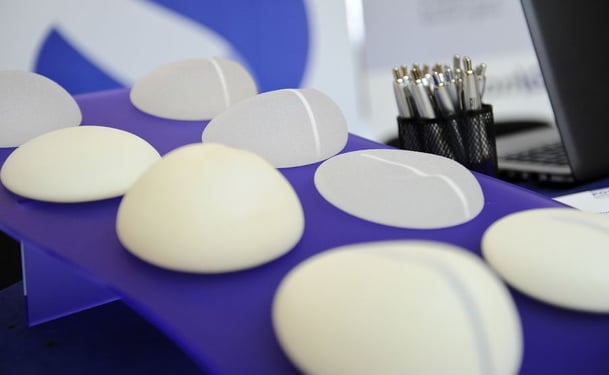One of the major decisions in planning your breast augmentation is whether to choose saline or silicone implants. They both have their benefits, as we will discuss below. Use this information to help you choose the best design of implant for your body and lifestyle.
Saline breast implants
Despite their name, saline implants have a rubber shell made of silicone. The implants are placed in their deflated form under or above the pectoralis muscle and inflated with sterile saline solution to the desired size at the time of operation. Saline is essentially salt water and is similar to fluid found naturally in the human body.
The shell surface of saline implants is either smooth or textured, and the implant itself varies in volume, shell thickness, profile, and shape. They are also expandable. There are pre-filled saline implants filled by the implant manufacturer, however none of them have FDA approval at this time.
Saline breast implant sizes range from 120cc to 960cc. If you want implants larger than 850cc, you will need custom implants. Currently, only Mentor Corp. and Allergan manufacture these types of saline implants in the United States.
Saline Breast Implant Facts:
- Smaller cost compared to silicone by about $2,000
- Smaller incision compared to silicone
- Ruptures easier to detect than with silicone
- Smaller rate of capsular contracture compared to silicone
- Feels firmer than silicone
- Because the implants are not pre-filled, the patient can go up in size
Silicone breast implants
Silicone implants have a durable, elastic silicone shell filled with silicone gel that mimics the feel of natural breast tissue. They come in round and teardrop (anatomical) shape, and in both smooth and textured shell surfaces.
Most silicone gel-filled implants are not adjustable, and therefore the incision used to place the silicone gel implant is larger than the incision needed for saline implants. Since they aren't adjustable, they come in an exact size that is permanent (unlike saline implants).
Some doctors recommend silicone implants for slender women with less fat and body tissue to hide the implant. If a patient has enough breast tissue to cover the implant, the final result will be similar when comparing saline implants versus silicone gel implants.
If a patient has very low body fat and/or very little breast tissue, the silicone gel implants may provide a more natural result. However, most women are eligible for silicone breast implants.
Silicone Breast Implant Facts:
- Feels more like natural breast tissue compared to saline
- Each implant has a set volume that will give you a predictable result
- If it ruptures or leaks, the silicone gel is not released into the body, unlike saline
- Less chance of rippling compared to saline
- Works for many body types
Saline vs. silicone breast implants
Saline implants have some major advantages over silicone implants.
One major concern with most breast augmentation patients is the chance of rupture in either type of implant. When a breast implant ruptures, the outer shell of the implant tears. This is likely from physical trauma, capsular contracture, or complications from other medical procedures.
Silicone implant ruptures are harder to detect. When saline implants rupture, they deflate and the results are immediately visible.
When silicone implants rupture, the breast often looks and feels the same because the silicone gel may leak into the surrounding areas of the breast without a visible difference. Patients will need an MRI to diagnose a silicone gel rupture. Consequently, replacing a ruptured silicone gel implant is more difficult than repairing a saline implant.
Updated October 2016



